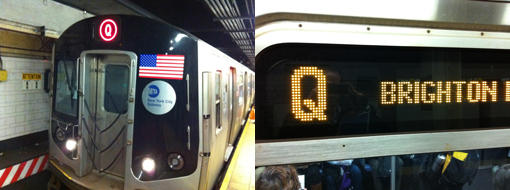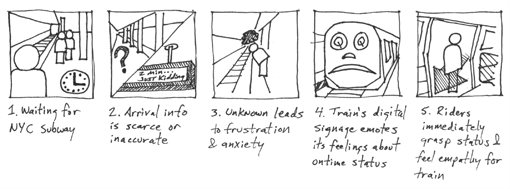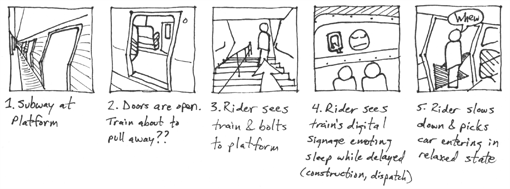Making Faces on the Subway
 Wednesday, March 28, 2012 at 7:42AM
Wednesday, March 28, 2012 at 7:42AM  And there’s even cooler nerdtastic digital signage on the inside of the newest model trains.
And there’s even cooler nerdtastic digital signage on the inside of the newest model trains.
I’ve been living in New York City for just over half a year now. Apart from my official computer science graduate studies in play+tech, one of my favorite topics of study is the subway system and the behaviors surrounding its use. I love the subway. I am becoming a total subway nerd.
First of all, what you need to understand is that the trains run fairly reliably, but there’s not much in the way of communicating arrival times when the trains are off schedule (and schedules are not usually posted in the stations to begin with anymore). So, people anxiously look down the tunnels for hints of headlights in the distance. Keep in mind that the tunnels often curve away from the stations so there’s not much to see. Some stations have digital signs for arrival information, but they aren’t always accurate. Reportedly, because of the limits of old signalling equipment and maybe even concerns about terrorism, the city isn’t terrifically motivated to deliver accurate arrival times. I could be wrong about this. My point is that train arrival is often frought with anxiety.
I found this behavior of impatiently and habitually peeking down the subway tunnel rather fascinating. It’s an unintended user interaction model afforded by the subway’s design. It seemed something really interesting could be done with the tunnel entranceway or that moment when a train appears there.
For an HCI (Human Computer Interaction) class with my advisor, we were recently given the assignment to anthropomorphize an everyday item and to depict our concept as a storyboard. Inspiration struck. My storyboards are embedded in this post.
 Storyboard #1 — Click to embiggen.
Storyboard #1 — Click to embiggen.
Since more robust arrival information isn’t available, perhaps the digital signage of the newest model trains could be reconfigured to transform the train itself into a character. In this way we could communicate something valuable about the train’s status while simultaneously engendering empathy with the riding public. Something like a real life Thomas the Tank Engine. The approach of creating a face has the added benefit of cross-cultural communication — by and large facial expressions are universal.
One of my team members suggested that we go further by incorporating sound into the mix. So we envisioned changing the familiar bing-bong of the doors opening to speed up when the train is on time and chipper and slow down when it’s behind schedule and melancholy. We even talked about adding a new child’s voice to the automated messages talking about how the train is feeling (no storyboards for these ideas).
 Storyboard #2 — Click to embiggen.
Storyboard #2 — Click to embiggen.
The second thing you need to understand about the trains is that there’s an understood etiquette of sorts. When a train is at a station, it’s about to leave any moment. If you run to it and the conductor sees you, they will generally hold the doors so you can jump on. This works fairly well. Except for when the trains are stalled at the station due to construction or dispatch tie ups. At which point the train will sit at a station for an extended period of time with its doors open. For the average subway rider, seeing this is cause to rush to the train; they have no way to know how long the train has been there. Cars closest to the stairways fill to capacity while others remain relatively empty. And riders dash to the cars only to realize that they ran like an idiot for no reason.
So why not anthropomorphize the train to communicate when it’s sleeping? Or for that matter, there’s several facial expressions that could deliver valuable information on the train’s status all along the subway platform.
While technically this constitutes anthropomorphic design, I say these ideas are also a fine example of the potential for injecting playfulness into everyday technological systems.


Reader Comments (3)
I love the first storyboard and concept. I think that really works... particularly the face. The only dissenting feeling was when you were talking about sounds. To me, the sound would speed up when he (she? Clearly the train has a gender and is not "it") is behind because he is feeling rushed.
Interesting point. There are probably multiple emotional responses that apply to that moment of entering the train when it's off schedule. Expressing remorse would seem to be one response necessitating a slower, down tempo sound experience. But expressing the sense of being in a rush could also be appropriate. If this were to ever become real (could it??) I think lots of trials with trains full of real people would be necessary to understand and evaluate the effect. I should add that in the post I only mentioned changing the playback speed of the sound when in reality, we meant also altering its frequency and pauses/syncopation as well as changing the lilt at the tail end to shape the sound.
Mike,
I love your idea! I for one can empathize with your story, even with the little I've ridden the subway. For the occasional subway user, this scenario is even more nerve-wracking. There are too many things to watch, learn, decipher, assume, and know which is compounded as a newbie.
It strikes me, this type of thing could also be true for city buses. Or for that matter, other types of public transportation??
Keep up the awesome work and I hope to see it in action someday!
Paul